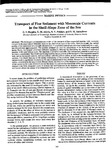Transport of fine sediment with mesoscale currents in the shelf-slope zone of the sea
| dc.contributor.author | Shapiro, Georgy | |
| dc.contributor.author | Akivis, TM | |
| dc.contributor.author | Pykhov, NV | |
| dc.contributor.author | Antsyferov, SM | |
| dc.date.accessioned | 2017-08-10T13:49:15Z | |
| dc.date.available | 2017-08-10T13:49:15Z | |
| dc.date.issued | 2000 | |
| dc.identifier.issn | 0001-4370 | |
| dc.identifier.uri | http://hdl.handle.net/10026.1/9745 | |
| dc.description.abstract |
We developed a semianalytical model of the transport of fine suspended material with mesoscale currents in the near-bottom boundary layer in the shelf-slope zone of the ocean. With this model, the vertical profiles of the horizontal velocity and concentration of suspended material are calculated analytically in a quasi-one-dimensional approximation. The profiles obtained are used for calculations of the horizontal suspended matter fluxes. An integral advection-diffusion equation is deduced for describing the balance of suspended material in the near-bottom layer. The equation is solved numerically. The sedimentary material is assumed to be weakly consolidated. The model can be employed for the calculation of the transport of fine suspended material with various mesoscale currents, such as cyclonic and anticyclonic eddies, as well as by meandering longshore currents. It is shown that due to the strong nonlinearity of the problem, small variations in the intensity of a current result in significant variations in the rate of sedimentation and erosion. Because of the onset of the secondary circulation in the near-bottom Ekman's layer, the direction of the suspension transport and the direction of the current in the water thickness are not the same. It is shown that mesoscale eddies moving along the continental slope form elongated zones of erosion and sedimentation in the direction of their propagation. This mechanism allows the matter to be transported both up and down to the continental slope. | |
| dc.format.extent | 305-311 | |
| dc.language.iso | en | |
| dc.title | Transport of fine sediment with mesoscale currents in the shelf-slope zone of the sea | |
| dc.type | journal-article | |
| dc.type | Journal Article | |
| plymouth.author-url | https://www.webofscience.com/api/gateway?GWVersion=2&SrcApp=PARTNER_APP&SrcAuth=LinksAMR&KeyUT=WOS:000088979500002&DestLinkType=FullRecord&DestApp=ALL_WOS&UsrCustomerID=11bb513d99f797142bcfeffcc58ea008 | |
| plymouth.issue | 3 | |
| plymouth.volume | 40 | |
| plymouth.publication-status | Published | |
| plymouth.journal | OCEANOLOGY | |
| plymouth.organisational-group | /Plymouth | |
| plymouth.organisational-group | /Plymouth/Faculty of Science and Engineering | |
| plymouth.organisational-group | /Plymouth/PRIMaRE Publications | |
| plymouth.organisational-group | /Plymouth/REF 2021 Researchers by UoA | |
| plymouth.organisational-group | /Plymouth/REF 2021 Researchers by UoA/UoA07 Earth Systems and Environmental Sciences | |
| plymouth.organisational-group | /Plymouth/Research Groups | |
| plymouth.organisational-group | /Plymouth/Research Groups/Marine Institute | |
| plymouth.organisational-group | /Plymouth/Users by role | |
| plymouth.organisational-group | /Plymouth/Users by role/Academics | |
| plymouth.organisational-group | /Plymouth/Users by role/Researchers in ResearchFish submission | |
| dc.rights.embargoperiod | No embargo | |
| rioxxterms.licenseref.uri | http://www.rioxx.net/licenses/all-rights-reserved | |
| rioxxterms.type | Journal Article/Review |


